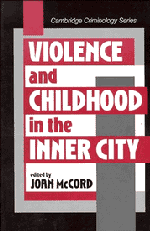Book contents
- Frontmatter
- Contents
- List of Contributors
- Preface
- 1 Violence and the Inner-City Street Code
- 2 The Embeddedness of Child and Adolescent Development
- 3 Placing American Urban Violence in Context
- 4 Neuropsychology, Antisocial Behavior, and Neighborhood Context
- 5 Psychological Mediators of Violence in Urban Youth
- 6 Understanding and Preventing Child Abuse in Urban Settings
- 7 Intervening to Prevent Childhood Aggression in the Inner City
- Name Index
- Subject Index
4 - Neuropsychology, Antisocial Behavior, and Neighborhood Context
Published online by Cambridge University Press: 01 June 2011
- Frontmatter
- Contents
- List of Contributors
- Preface
- 1 Violence and the Inner-City Street Code
- 2 The Embeddedness of Child and Adolescent Development
- 3 Placing American Urban Violence in Context
- 4 Neuropsychology, Antisocial Behavior, and Neighborhood Context
- 5 Psychological Mediators of Violence in Urban Youth
- 6 Understanding and Preventing Child Abuse in Urban Settings
- 7 Intervening to Prevent Childhood Aggression in the Inner City
- Name Index
- Subject Index
Summary
Introduction
The belief that neuropsychological factors are among the causes of antisocial behavior is not new. For example, Benjamin Rush (1812, p. 360, cited in Elliott, 1978, p. 147) referred to the “total perversion of the normal faculties” in people who displayed “innate preternatural moral depravity.” Rush proposed that “there is probably an original defective organization in those parts of the body which are occupied by the normal faculties of the mind” (p. 147). Since Benjamin Rush's day, quite a bit of research has been done to put his hypothesis to the scientific test. A relatively new field, called neuropsychology, has emerged to study the relations among “parts of the body” (the brain) and “faculties of the mind” (mental abilities and personality styles). Modern research methods have improved our ability to understand the role of neuropsychological factors in antisocial behavior.
Why should a chapter on neuropsychology be included in this book about childhood aggression in the inner city? In 1987, Sarnoff Mednick drew a connection between inner-city decay and research on biological and psychological correlates of criminal behavior. He wrote,
We must not permit honest research efforts to be ignored simply because in the nineteenth century [eugenicist] Herbert Spencer twisted the theory of evolution to selfish, bigoted ends. Let us try to turn this sharp tool of knowledge to the correction of social injustice. Our cities, the strongholds of art, literature, music, and science, have decayed. […]
- Type
- Chapter
- Information
- Violence and Childhood in the Inner City , pp. 116 - 170Publisher: Cambridge University PressPrint publication year: 1997
- 24
- Cited by



